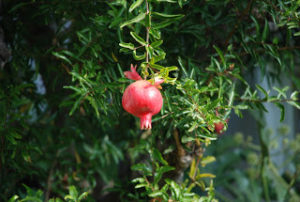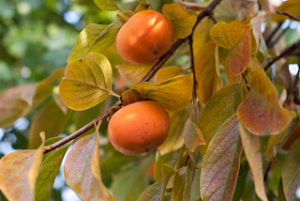
Photo of Pomegranate, courtesy of Kristen Taylor.
Fall is an interesting time of year. When many of our summer plants are beginning to wither and our stone fruit trees have dropped their last fruit, something quite unusual happens. Two trees, pomegranates and persimmons, become full of bright, colorful fruit.
Persimmons are also a medium size fruit with a hard exterior. They begin as small green/yellow berries that ripen to a deep orange color. As the fruit ripens and softens the exterior becomes edible. Make sure you eat a persimmon only when it has fully ripened; if you try to eat one too early it will make your mouth pucker. Prior to ripening, the persimmon shell is full of tannic acid, which makes it bitter tasting. There are some varieties that are non astringent such as the Fuyu and those can be eaten before they are fully ripened. In fact it is very common for Fuyu Persimmons to be eaten while still crunchy. Persimmons are often used to make cookies and jams. They are pervasive within East Asian culinary cultures and they were extremely important to early Native Americans.

Photo of Persimmon, courtesy of Frank Chan.
Interestingly, many persimmons in the US, including Asian varieties are grafted onto a North American rootstock. We had a Fuyu persimmon in our demonstration garden which, due to high winds, broke at the graft. Now the rootstock has created new growth, so we’ll be getting a North American variety instead of an Asian variety. I’m looking forward to seeing how those fruits turn out.
The IEUA Garden in Every School program uses both of these fruit trees in many of our school gardens. Take a look in your garden to see if you have any pomegranates or persimmons. If you’re feeling brave, grab a few pomegranates and come up with your own way to harvest its seeds. Or, for a more educational venture, look up the different uses for persimmons in Asian cuisine. You will probably find several varieties that you have never seen before.
